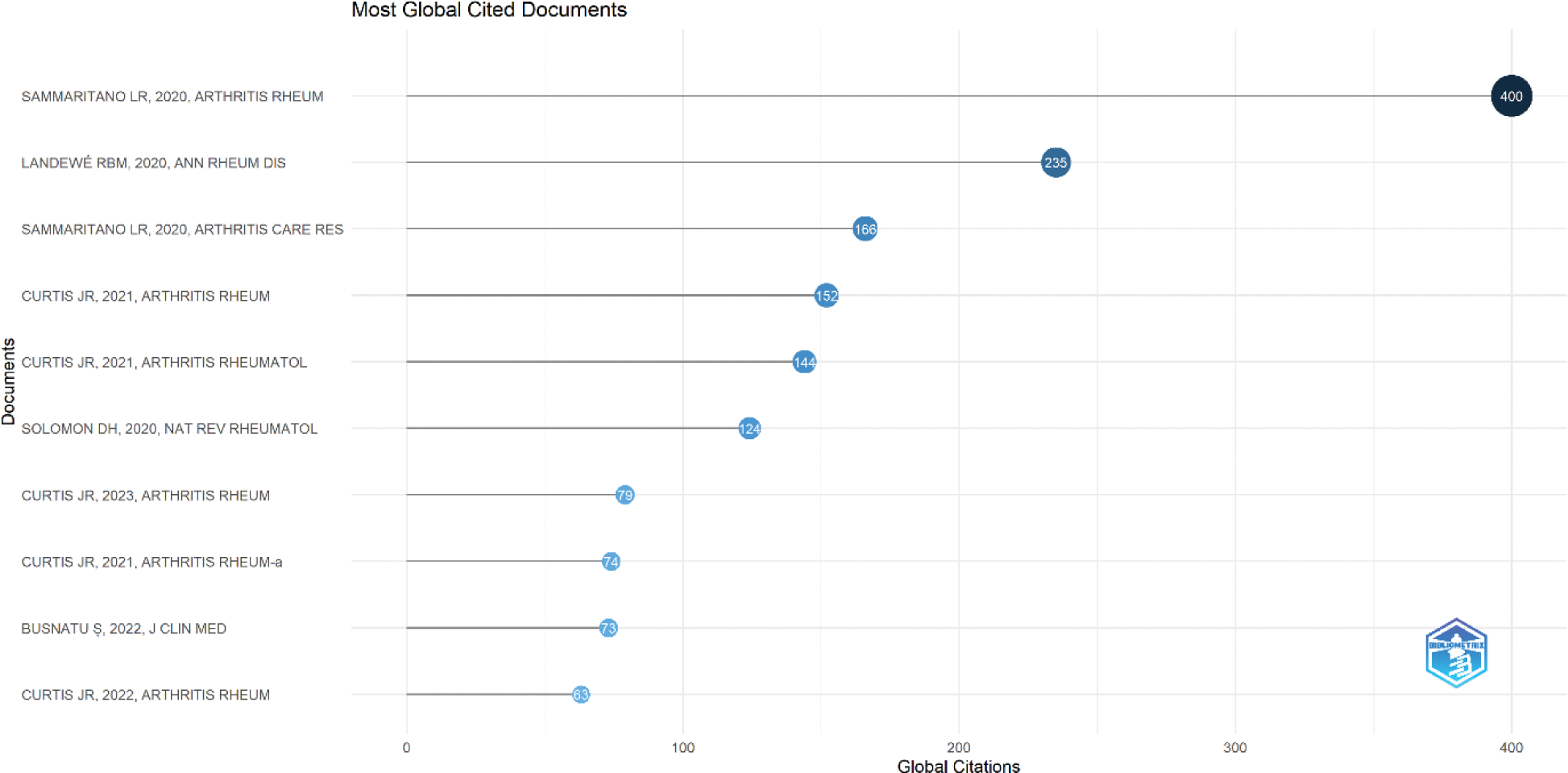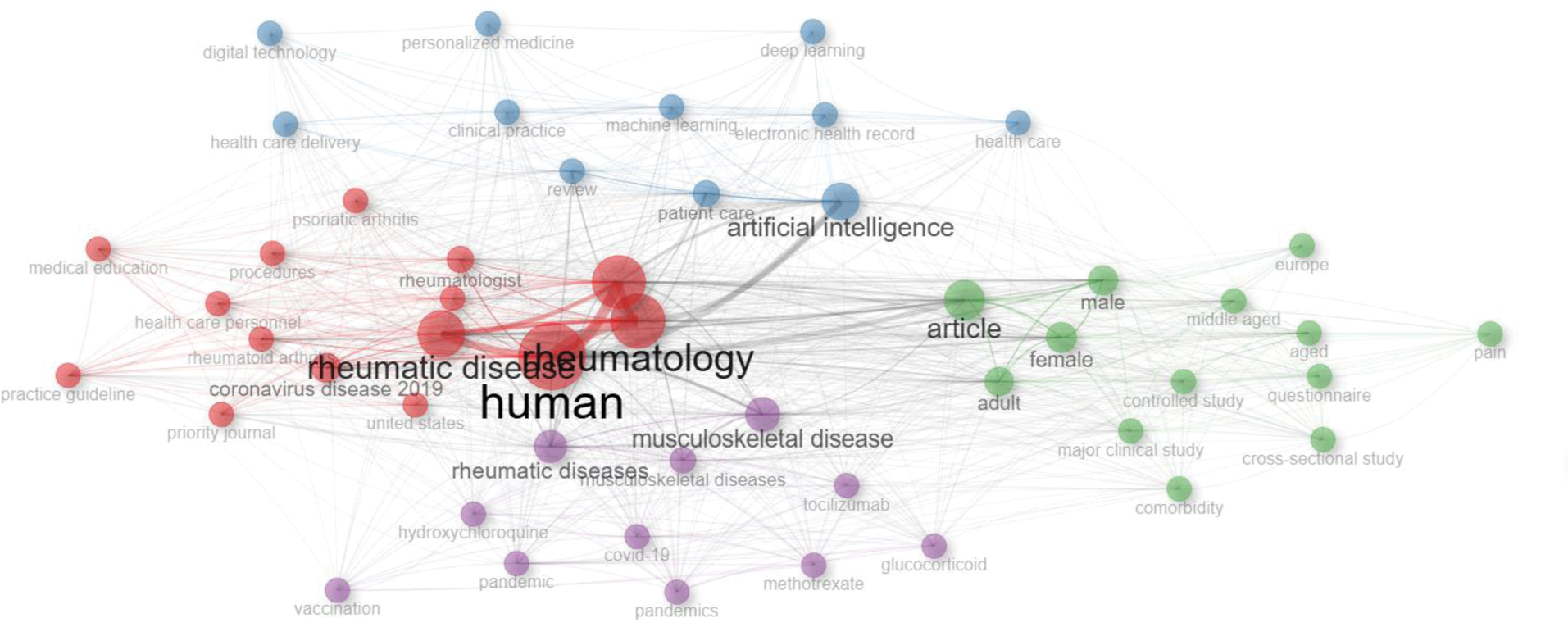

Background: Artificial intelligence (AI) has emerged as a transformative technology, significantly enhancing processes across various domains, particularly in healthcare. In the realm of health care, the integration of AI not only optimizes research and diagnostic methods but also accelerates the development of innovative applications for patient care, including monitoring and treatment. The impacts of AI in specialized areas such as rheumatology health care hold the potential to revolutionize patient outcomes by improving precision and personalization in care delivery.
Objectives: This study aims to conduct a comprehensive bibliometric analysis of scientific publications that explore the applications of AI in health care, with a particular focus on its use in rheumatology. The objective is to uncover trends, contributions, and future directions in this intersection of technology and medical science.
Methods: Using the Scopus database, 84 publications published between 2020 and 2024 were identified with the keywords “health care, rheumatology and artificial intelligence.” These studies, sourced from 43 different journals, were authored by a total of 510 unique contributors. The collected data was systematically analyzed using the Bibliometrix software to uncover key trends and insights.
Results: The most frequently referenced sources were Arthritis and Rheumatology and Annals of the Rheumatic Diseases . Citation analysis revealed that the most cited document was Sammaritano LR, 2020, Arthritis Rheum (400 citations), followed by Landewé RBM, 2020, Ann Rheum Dis (235), and Curtis JR, 2023, Arthritis Rheum (79) (Table 1). Highly cited publications represent foundational works that guide both clinical applications and academic studies in the intersection of artificial intelligence and rheumatology. Publications focusing on artificial intelligence in rheumatology have shown a steady increase over the years. According to Bradford’s Law, Arthritis and Rheumatology and Annals of the Rheumatic Diseases are the core journals in the literature on artificial intelligence applications in rheumatology. Based on Lotka’s Law, the majority of publications were authored by a small number of researchers. However, a minority of prolific authors contributed significantly to the literature. The United States leads scientific production in this domain, while European countries also play a significant role in advancing research. Among European countries, the United Kingdom, Germany, Italy, France, and the Netherlands rank as the top contributors. Bibliometric analyses revealed keyword clusters that indicate key focus areas in artificial intelligence and rheumatology. Prominent themes include “rheumatic diseases,” “musculoskeletal disease,” and “article,” which represent central topics driving the field. Themes such as “human” and “rheumatology,” with lower centrality and density, represent emerging or less developed areas. Thematic maps categorized the literature into four main groups: niche themes, motor themes, basic themes, and declining themes. Motor themes such as “musculoskeletal disease” and “rheumatic diseases” dominate as primary areas of focus in artificial intelligence applications within rheumatology. Less developed but promising areas such as “human” and “rheumatology” fall into this category. Since 2020, topics related to artificial intelligence have shown a growing presence in healthcare publications. Frequently recurring terms include “artificial intelligence,” “machine learning,” “telemedicine,” and “medical education.” Key significant trend topic terms during 2023 and 2024 include “rheumatoid arthritis,” “health care personnel,” “medical education,” “artificial intelligence,”machine learning,” “telemedicine,” and “coronavirus disease 2019.” These terms highlight the diverse applications and focus areas within this domain. For example, “rheumatoid arthritis” and “rheumatology” emphasize the core clinical conditions studied, while “health care personnel” and “medical education” underline the role of AI in improving healthcare delivery and training. Additionally, terms like “machine learning” and “telemedicine” reflect the technological tools and innovations shaping the future of patient care and research in this field. This variety of terms illustrates the growing integration of AI technologies in rheumatology healthcare and their expanding relevance across different facets of medical science and practice. The findings are presented in Table 2 as a network visualization of co-occurrences in keywords related to artificial intelligence and rheumatology.
Table 1. Top Cited Documents in Artificial Intelligence Applications for Rheumatology and Healthcare.

Table 2. Network Visualization of Co-Occurrences in Keywords Related to Artificial Intelligence and Rheumatology.

Conclusion: The findings demonstrate that artificial intelligence is increasingly integrated into rheumatology healthcare, particularly in enhancing diagnostics, treatment strategies, and patient management. Prominent themes and highly cited works highlight the pivotal role of AI in addressing real-world challenges, while emerging topics indicate areas of growth for future research.
REFERENCES: [1] Topol, E. J. (2019). High-performance medicine: The convergence of human and artificial intelligence. Nature Medicine , 25(1), 44–56.
[2] Yu, K. H., Beam, A. L., & Kohane, I. S. (2018). Artificial intelligence in healthcare. Nature Biomedical Engineering , 2(10), 719–731.
Acknowledgements: NIL.
Disclosure of Interests: None declared.
© The Authors 2025. This abstract is an open access article published in Annals of Rheumatic Diseases under the CC BY-NC-ND license (